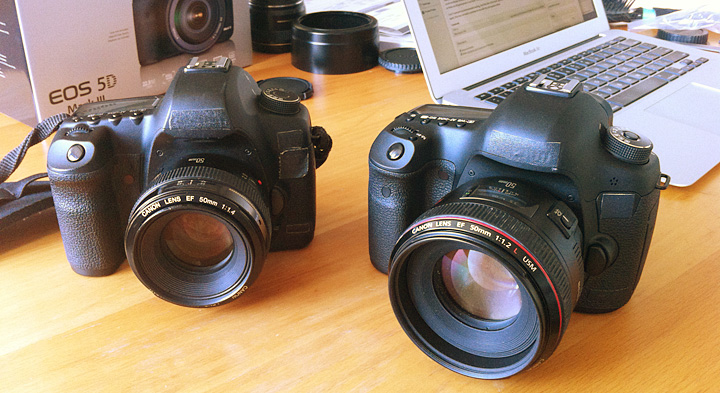I’m still in the process of updating this post as I play and have a chance to write my experiences.
So beware, it’s alive!
About an hour ago, Fed-Ex dropped off my new Canon 5D Mark III which I pre-ordered a couple weeks ago from OneCall out in Spokane, WA (They’re not a sponsor, but I’ve found them a great place to buy stuff).
I’ve got my new camera ritual which involves covering all of the Canon markings with tape while the battery is fully charging. And since that’s happening right now, I thought I’d start with the tactile stuff. I have since updated the post with more observations and a few corrections.
Build
First off, the Mark II felt a lot like the original 5D. This new camera does not to me. Others have mentioned this, but I’d like to concur that it feels much closer to a 1D body than old ones ever did. Like a 1D without the portrait grip buttons. Overall it’s a bit heavier, a bit thicker front to back, so that the grip is better for bigger hands like mine. The prism bump is also bigger, to fit the new 100% viewfinder (finally!). I personally want a camera that’s a little bigger in the hands, with a little more heft to keep things steady, so these are all good points in my book. The bigger size also makes it feel like front heavy with big lenses like the f/1.2 primes.
I can’t comment on environmental sealing, but if the feel of the build quality is an indication, I’d assume it’s improved as well. Then again, that was not really a problem for me with the old cameras either.
Controls
A few changes on the controls as well. First is that the mode dial requires you to push the center down to turn, thus locking it from changing in your bag or against your side as your carry it over your shoulder. There’s a dedicated still/movie switch instead of relying on the little live-view button as on the old one. Apparently there is a rating button so that you can give star ratings in camera. This sounds great as long as it’s all using the same metadata slot so that they show up starred in Lightroom when I import (Update: The ratings do successfully transfer to Lightroom).
As well as the rating button, there’s a new Zoom button. On the Mark II you used the focus select button and the one next to it to zoom in and out of the current image on the review screen. It involved a lot of tap-tap-tapping of buttons, but I was used to it. Now you press the zoom button with your left hand and roll the dial up by the shutter to zoom in/out. Something new to get used to. And it looks like you can now zoom all the way in to 100%. On the old camera preview was limited to the resolution of the small preview jpeg. The only thing I don’t like about that so far is that when you’re zooming back out it goes past the current full image and all the way out to a thumbnail view of all your images. So you can’t just blindly zip the dial to get back to fit. There should be a setting for that somewhere.
And speaking of controls this is as good a place as any to mention the screen, which is pretty nice. Now wider than the last one and truly 3:2 so that images fill the screen. Looks bright and accurate. Nothing bad to say here, other than to mention how far we’ve come with the screens on the back of cameras. Remember when they were 1.8″ and 320×240? Me too. Wow.
Viewfinder
The new viewfinder is bright and big. A bit bigger than the Mark II, and the focusing screen they used is much more matte than in the old camera and a tad darker. This is good news for me because I like to be able to see the lens’ depth of field. We’ll see how it works in practice.
Another interesting thing is that there are no markings in the viewfinder without power. It’s all a EVF kind of thing. I hear there are settings to show/hide the AF points and exposure data from the bottom as well (Update: I can’t find a way to turn the exposure data off, though I’d love to). That all sounds delightful to me. Makes it feel like you’re shooting with an old analog camera. Less visual clutter.
One weird thing I’ve noticed is that if I have no battery in the camera and just manually focus the lens, it’s completely off. Infinity is focused about 6ft away and all the way in is almost macro, and that’s on a lens that normally can’t focus below 24″ or so. I thought something was wrong with the camera (and perhaps there is), so much so that I grabbed the battery off the charger, but the instant I hit the focus button, everything worked fine. Weird and curious.
Shutter
The Mark III shoots like 14,000 frames per second. Ok, actually only 6, but even that is about double the Mark II. I rarely shoot anything but single shot anyways so this isn’t cool beans to me. However it does me that they had to improve the shutter system a bunch in order for it to move that fast and handle that many actuations. The practical upshot of this for me is that the shutter black-out, which is the time where the viewfinder goes black while the mirror pops up and exposes the sensor, is now almost nonexistent, which is amazing to me. It’s one of the big things I missed moving from the 1Ds to the 5DII, so I’m back in nirvana.
The new shutter also sounds great. I know it’s a fetishy kind of thing, but it matters. Makes the whole package feel more responsive. Like when you put an SSD in your computer for the first time and now every computer without one feels broken.
In addition, Canon has added silent shutter mode. We’re talking very quiet, as in Leica quiet. It adds to the shutter lag a bit, but I think it could be useful if you’ve got to take picture during a performance, interview, or video shoot.
The Files
Let’s talk turkey, because all the rest of that isn’t worth a hill of beans unless the images look good. I’m not going to do a side-by-side comparison of the Mark II and III. There are plenty of sites out there who will do that kind of anal testing. For me it’s whether the sensor does a good job of capturing the image I focus onto it, and if the RAW files are malleable. That is, if they can be manipulated well. Shadows pulled up without a lot of noise, blown-out highlights retrieved and that kind of thing.
To that end I went up to Prospect Park around dusk last night and took some artistically terrible pictures with my 35mm/1.4L lens. Their saving grace is that they’re good tests of some of the extremes of what I’m talking about and therefore, perfect for our purposes.
The main workflow problem I’ve encountered is that Lightroom does not yet support the 5D Mark III’s .cr2 RAW files. Seriously camera company people, just start writing them to card as DNG, everyone will be better off. Anyhow, I found a release candidate of the next Adobe Camera Raw plugin and converter, which I used to convert them to DNGs which I then brought into Lightroom. I’m sure this will be fixed with an update within the next few days, but in the meantime, there is a way around it folks and that’s the system I used for the examples below.
By the way, I tried the supplied Canon DPP software before finding the converter and I will spare you how frustrating I found using it. Honestly, if that were the only RAW conversion option, I’d shoot JPEG. OK, enough with the rant, back to the results.
First is a shot of a barren tree silhouetted against the sky. ISO 400 at f/6 1/160th of a second. Again, not a good photograph, but a good test of high-contrast detail. And it’s plenty sharp to me. Minimal processing, I turned on lens and CA corrections in Lightroom, opened up the shadows a bit (which they did nicely) and used default sharpening which is pretty conservative. Sharp all the way to the edges. This is why I shoot with high-end prime lenses by the way. Click here to load the full res image into a new browser window and you can see for yourself.
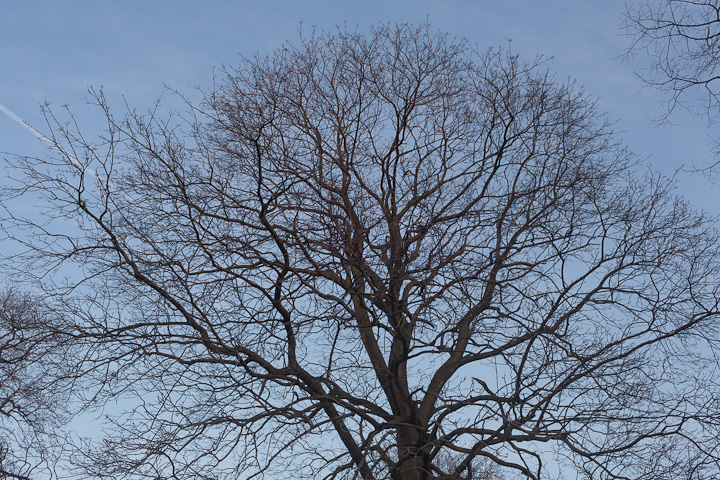
Here’s what the branches at the very top of the tree look like at 100%. Ya, that’ll do.

Next up is a very high-contrast backlit shot. Again, terrible photograph, but good for our purposes. Also iso 400 with blocked up shadows and blown out highlights. Good test of malleability.
Here’s how it looked on import:
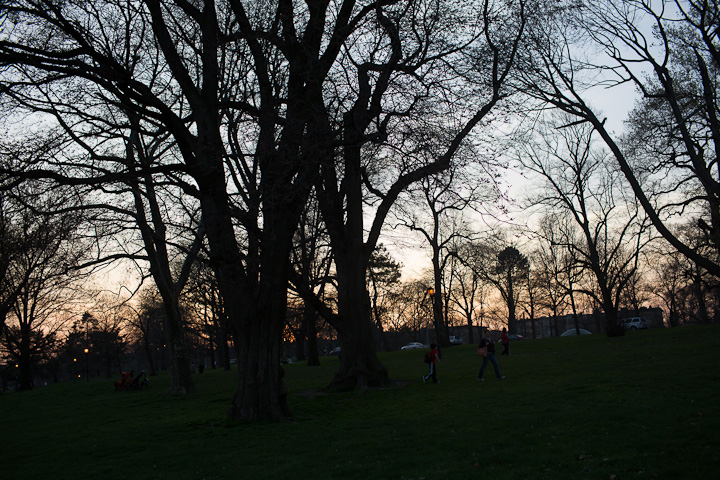
After a bit of opening up shadows and pulling back highlights:
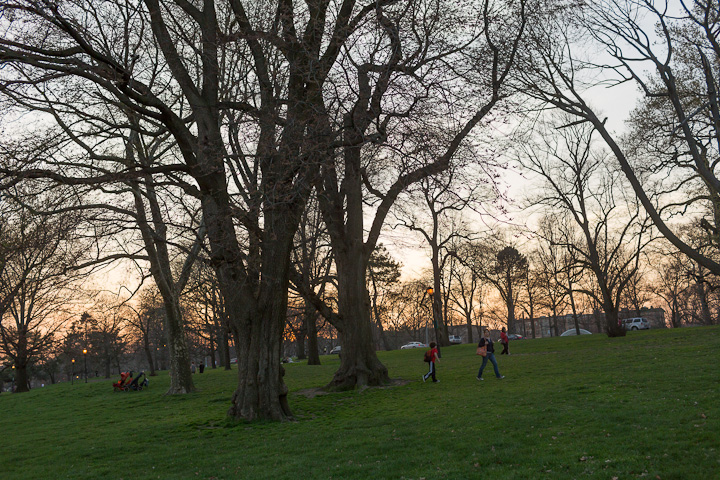
A small chunk of it. A little shadow noise, but that’s without any noise reduction and I did a fair amount of digging in those shadows.
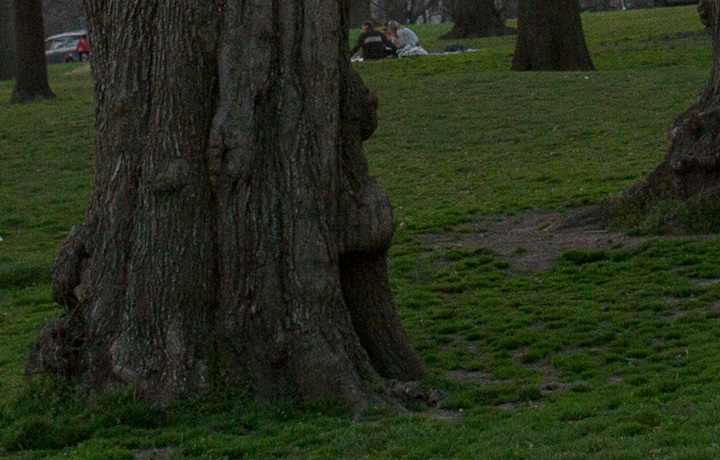
Overall I’m quite pleased. Plan to take it out with me today to take some real pictures. More to come.
So Close
There are a few things Canon got SO close on, but missed in the end. They added a ratio crop mode, so that you could for example shoot square or 4×5. However the crop lines don’t show up in the viewfinder, but rather only when you’re using Live View, which rarely if ever interests me. I use an SLR because I like a viewfinder, thank you very much. Nikon has had this for a while and I was excited when I saw it on the spec sheet, but they let me down.
I also wish they had moved the diopter control deeper under the eye cup. I’ve already changed it inadvertently. To the point where I’ve gone and used a bit of gaff under the eye cup to keep it in place. Seems to be a decent if hack solution.
—-
If you’re thinking about ordering one from Amazon. You can use this link and help support the site at the same time.
Canon EOS 5D Mark III 22.3 MP Full Frame CMOS with 1080p Full-HD Video Mode Digital SLR Camera (Body)
Oh and my Mark II is now officially for sale if anyone in New York City is interested. I’m looking for $1750 cash.

